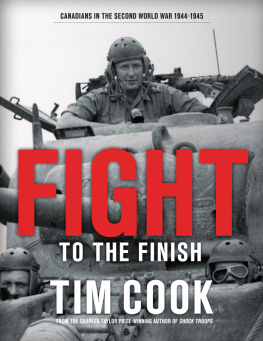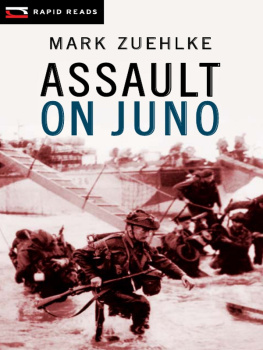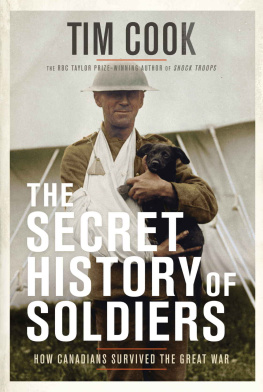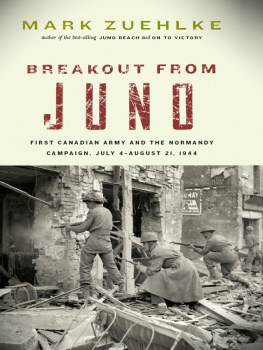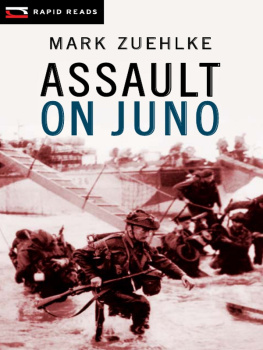TIM COOK

FIGHT TO THE FINISH
CANADIANS IN THE SECOND WORLD WAR 19441945
VOLUME TWO


For Flight-Lieutenant Gordon Francis Cook (19141974)
and Dr. Terry Gordon Cook (19472014)
Also by Tim Cook
No Place to Run
Clios Warriors
At the Sharp End:
Canadians Fighting the Great War,
19141916, Volume One
Shock Troops:
Canadians Fighting the Great War,
19171918, Volume Two
The Madman and the Butcher:
The Sensational Wars of Sam Hughes
and General Arthur Currie
Warlords: Borden, Mackenzie King,
and Canadas World Wars
The Necessary War:
Canadians Fighting the Second World War,
19391943, Volume One
CONTENTS
MAPS
INTRODUCTION
At Bny-sur-Mer, in France, the Commonwealth War Graves Commission cemetery contains 2,048 gravestones. All but five are Canadians. The cemetery is at the top of a gentle rising hill with a view of Juno Beach, where the Canadians came ashore on June 6, 1944. Among the immaculate green Normandy lawns, row upon row of uniform, white gravestones lie throughout the tranquil space. The symmetrical lines of graves stretch out, creating an optical illusion of sorts, as they seem to shimmer and at times merge, to give the impression of a wall of stone. Above the sixteen sections of gravestones stands the Cross of Sacrifice, providing a focal point for the eye even as the trees cluster in places and provide a shroud from the sounds of the outside world. This is sacred land for Canada, and one of hundreds of Commonwealth cemeteries where more than 100,000 Canadian service personnel are interred.
The fallen came from big cities like Montreal and Vancouver, as well as a host of counties, villages, and farming communities such as Yorkton, Owen Sound, Cordova Mines, and Arnprior. The surnames on the gravestones range from Smith, Macdonald, Roy, and Tremblay to Husak, Cohen, Radoy, and Kachor. This is Canada embodied thousands of kilometres from home.
There are no fewer than twelve pairs of brothers at Bny-sur-Mer. Six families had to suffer through the death of two sons on the same day of battle. The grief of such unthinkable losses still emanates like heat from the matching headstones. The Westlake family of Toronto lost one son on June 7, and then two more boys within the week. The official missives would have arrived one shattering blow after another. Another family, the Wagners of Teeterville, Ontario, had a son buried at Bny-sur-Mer, another It was the route of Canadian battles, soaked in blood and tears. And it did not stop with Northwest Europe. Families across Canada saw their sons buried in Sicily and Italy, in the jungles of Burma and the rocky ground of Hong Kong, next to the fiery remains of bombers along the route from Britain to Germany, and in the dark depths of the Atlantic.

The Commonwealth War Graves Commission cemetery at Bny-sur-Mer in France, near Juno Beach, contains the graves of 2,043 Canadians who died during the Second World War.
As in all Commonwealth War Graves cemeteries, the Canadian headstones in Bny-sur-Mer display a maple leaf emblem, except for two, which also feature the Star of David, for the Jewish-Canadian soldiers buried there.and file) that was worn on an ID tag around the neck along with rank, name, unit, date of death, and, in most cases, age at death. Nineteen of the headstones are for the unknownA Soldier of the 19391945 War; A Canadian Regiment, Known Unto God. Standing before those headstones and contemplating the events of seventy years ago, one quietly shudders at the thought of bodies so badly burned or dismembered that there was no piece that could be used to identify the man.
The most powerful symbols of grief are the short epitaphs from parents, wives, and children etched on the stones. These mournful farewells draw from scripture, hymn, songs, literature, and raw sentiment.
To the world he was just another one. To us, he was our darling son.
Private Lawrence Burton Perkins, Stormont, Dundas and Glengarry Highlanders, 7.6.44 (age 26)
Nous lavons donn a Dieu pour le salut de France. Son pre et sa mre. Canada.
(We gave him to God for the salvation of France. His father and mother. Canada.)
Private Leo Joseph Quevillon, Algonquin Regiment, 31.7.44 (age 21)
Life will never be the same now that we have lost you.
Ever lovingly remembered wife, son, mom and sister.
Rifleman Sidney Stephen Ryan, Queens Own Rifles of Canada, 6.6.44 (age 27)
He died to save us all. In our hearts hell always be.
Never forgotten by his wife and five children.
Private Soloman Kline, Canadian Scottish Regiment, 8.7.44 (age 38)
I have only your memory, Dear husband, to remember my whole life through.
Rifleman George Alexander, Royal Winnipeg Regiment, 16.7.44 (age 21)
Every stone and sentence is a forceful reminder of Canadians taken before their time. There would eventually be close to 45,000 of those headstones to mark Canadians who fought for freedom and liberty, to save the oppressed and occupied, and to defeat the evil of Fascism and Nazism. Canadian war hero Sydney Radley-Walters of the Notwithstanding what has been remembered or forgotten, those Canadian soldiers, sailors, airmen, nurses, and other service personnel who served during the Second World War understood that it was a war of necessity.
THE SECOND WORLD WAR was a war to prevent the total domination of Europe by Adolf Hitler and his Nazi Third Reich. The battles and campaigns fought by the Fascist, Communist, and democratic nations spanned the globe and unleashed ferocity, barbarism, and mass murder. German dictator Adolf Hitler had started the war to expand Germanys power, prestige, and geographic boundaries after the humiliating loss during the Great War of 1914 to 1918. War was also a means for Hitler, with his heinous Nazi ideology, to carry out his plan of subjugating the Slavic people of Eastern Europe and of removing and then annihilating the Jewish people of the same lands. The invasion of Poland on September 1, 1939, provoked the European war, although Hitler had already moved against his European neighbours before that, and Japan was engaged in a vicious struggle with China from 1937. Despite France and Britain having desperately tried to avoid war with Hitler in the late 1930s through appeasement and the sacrifice of democratic nations, actions that represented the will of most of their citizens, the move against Poland revealed that Hitler would never be satisfied and that he would continue to seek new campaigns to conquer and enslave millions.
Hitlers war dragged in almost all of Europe, and then much of the world; in the Pacific, Japan and the United States fought their own series of naval, aviation, and land campaigns from December 1941. In all theatres of war, clashing armies, navies, and air forces made targets of civilians, but it was only Nazi Germany that carefully crafted an official policy of genocide. With entire nations harnessed for prolonged war and their citizens indoctrinated into believing that only victory rather than negotiated settlement was a suitable outcome, the Second World War rapidly became a total war of domination, where defeat meant the destruction of ones society and way of life. The stakes were never higher and the nations of the world proved, in almost all cases, willing to accept millions of casualties and untold anguish in the pursuit of victory or the staving off of defeat.
Next page
